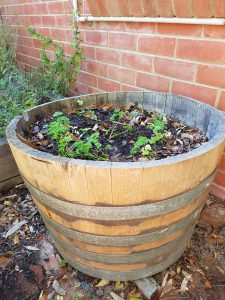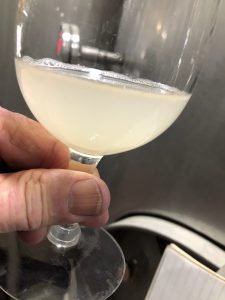 I know. I’m so sorry… I promise that will be the last pun!
I know. I’m so sorry… I promise that will be the last pun!
So, other than making a great place to grow your herbs when they’re cut in half, what are barrels for? And why are they important in the winemaking process?
Why oak?
Most red wines and some white wines are stored in wooden barrels made from oak. Why oak in particular? Well, there are a few reasons why it has become the wood of choice:
- the cellular structure and density of it prevents leakage
- it bends easily without cracking
- the physical dimensions of an oak barrel do not change considerably at different levels of humidity
- oak contains tannins that protect it against insects
- oak contains flavour compounds, which are complimentary to wines.
Although more than 600 species of oak can be found globally, only a handful are suitable for making wine barrels. The location of the trees is also important and they are usually sourced from areas in which they grow the tallest and straightest.
How are barrels made?
The making of a wine barrel is a tricky process, so I’ll leave it to a real-life cooper tell you how it’s done…
What type of oak has Rob been using recently?
When it comes to Somerled wines, Rob prefers a specific brand of French oak barrels called Chassin – sourced from a small family-owned cooperage in Burgundy. They are his particular favourite for the Chardonnay and Pinot Noir. He really likes the soft, fairly gentle spiciness of the new barrels. It doesn’t tend to dominate the flavour of the wine. That is, as long as he uses them in conjunction with older, more mature barrels.
What do we mean by that? Well, obviously a barrel can be used more than once. And the older it gets the less intense the oak flavours. So, for Rob, it’s important not to have the oak overpower the delicate fruit flavours of his wine. Therefore, he always stores his wine in a mixture of old and new barrels. Once the wine is fully matured and ready for bottling, some of the barrels will have a more intense oak flavour than others. When it’s all mixed together before bottling, this will even out to exactly the balance Rob is looking for.
How long can a barrel be used for before it needs to be turned into a pot for my herbs?
Barrels do have a certain life expectancy when it comes to their use in changing the colour, flavour, tannin profile and texture of wine. However, barrels are also useful simply as maturation vessels, due to the slow update of oxygen through the oak into the wine. The oldest barrels Rob uses were produced in 2009… at this stage, those barrels are no longer adding to the flavour profile of the wine.
Do barrels come in different sizes?
They sure do! The most commons sizes used today are a 300 litre barrel (also known as a Hogshead) and a 225 litre barrel (also known as a Barrique). Rob prefers to use hogsheads as it is generally easier to control the amount of oak and the rate of development. The smaller the barrel, the larger the number of barrels needed to store the wine and the greater the surface area to wine ratio… therefore the oakier (technical term!) the wine.
Back in the 70’s, Rob remembers using more of the 500 litre barrels (or puncheons) than anything else. The maturation was much slower in this size, but they were also very difficult to handle. These days, special racks designed to carried by forklift are specifically designed to hold hogsheads and barriques.
(Reference: Stern, Eric.2012. The Complexities of Barrels. Wine Business Monthly.
May 2012: 28-39.)
Any news from the winery?
Things have slowed down considerably in the winery as the wines do their thing.
 The Sauvignon Blanc is going through the fining process as we speak. It’s still pretty cloudy and gritty (as you can see in the photo), but the bentonite Rob is using with help to settle out the solids and prepare the wine for filtering and bottling.
The Sauvignon Blanc is going through the fining process as we speak. It’s still pretty cloudy and gritty (as you can see in the photo), but the bentonite Rob is using with help to settle out the solids and prepare the wine for filtering and bottling.
Everything else is ticking along as it should!

Slowing down in the winery yet heating up in the kitchen; the “Clafoutis” recipe accompanying with the May wines was a winner. Quince clafoutis and (as suggested) the pinot rose – just gorgeous!!
Great work John! Glad you enjoyed it.